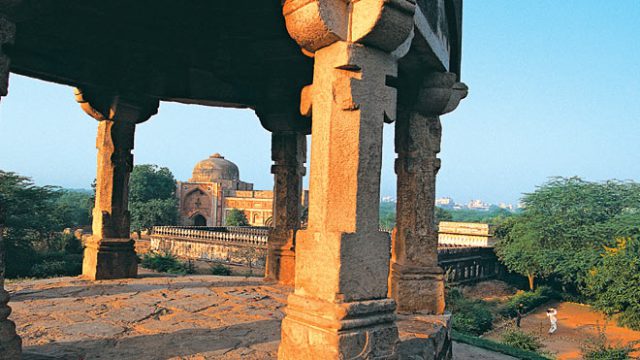DELHI
New Delhi
Displacing Calcutta as the new capital of British India, and an alternative to the congested Shahjehanabad, New Delhi was conceived as an imperial city with palatial Viceregal residences, grand official buildings, residential spaces and tree-lined boulevards. Connaught Place, an expansive colonnaded shopping and business hub, was the buffer between the two worlds. With India’s Independence, it became the political-bureaucratic hub of the government. Key Raj-era structures: Rashtrapati Bhavan, Parliament house, India Gate, Lutyens Bungalow Zone and Connaught Place. See delhiheritagewalks.com.
Mehrauli
The spectacle of ancient empires here compels a further acquaintance with the history and heritage of 1,000 years of Imperial Delhi. Mehrauli reflects the presence of the Slave, Khalji and Tughluk dynasties all of whom ruled Delhi at various points. The Qutub Minar and the nearby mosque mark the year Islamic rule began in the country. Mehrauli’s other important sites are the Iron Pillar, Dargah of Sufi saint Bakhtiyar Kaki, the Mehrauli Archaeological Park with the ruins of Lal Kot (700 CE), Zafar Mahal, two baolis, Hauz-i-Shamsi, Jahaz Mahal, Adam Khan’s Tomb, Balban’s and Jamali-Kamali Tomb and Mosque. See delhiheritagewalks.com.
Botanical City
Delhi’s rulers loved gardens and scattered around the city are not just formal gardens, but also tree-lined avenues and flowering roundabouts. In February, the city is ablaze with its generous floral delights and even the Mughal Gardens at the Rashtrapati Bhavan are opened to the public. Delhi Tourism’s Garden of Five Senses hosts a music festival in the winter as does Nehru Park. India Gate’s lawns are for an ice cream outing. At Emperor Humayun’s Tomb witness the perfection of a Mughal charbagh. Sunder Nursery is being renovated and don’t miss the mughal-era Qudsia Gardens. See delhitourism.com/sightseeing/gardens.html
DADRA & NAGAR HAVELI
Nestled between the states of Maharashtra and Gujarat, Dadra & Nagar Haveli offers a peaceful break from the bustling city life. Filled with a variety of fauna and rejuvenating greenery, it provides one an affinity with nature. Once a Portuguese colony, it has remnants of its colonial past, and is home to many colourful tribes documented about in museums such as the Tribal Museum in Silvassa. Those seeking peace and looking to evade the ‘travel-cliché’ tag, look no further. The nearest airport is located in Mumbai, which is 164 kms away.

DAMAN & DIU
A true relic of Portuguese rule in India, a visit to Daman & Diu will certainly confuse you about your whereabouts. The union territory is defined by glorious European churches such as the Church of Our Lady of Fatima, buildings with tall-panelled, marble-pillared architecture spelling out a classical European style and majestic bright beaches with salt-white sand. Other attractions such as the Gangeshwar Temple, dedicated to Shiva, are reminders of this territory’s indigenous culture that was diluted once the colonisers arrived. There are regular flights to Daman from Mumbai, which is 170kms away, and Vadodra which is 300 kms away.

LAKSHADWEEP
Made of coral deposit or accumulated remains of marine invertebrates, Lakshadweep can be thought of as a living entity by itself. The islands’ ecosystem is very delicate and fragile, because of which tourist visits require a permit available at lakshadweep.nic.in/depts/revenue/entry_permits.htm Here, one can sit by the jetties along islands such as Kadmat, Bangaram and Kavaratti, and observe what seems like a 20th-century painting come to life. Or, they can walk the beaches with careful precision since it disturbs an otherwise nearly untouched surface. The beach at Kadmat, interestingly, has rice-grain-like sand making it unique. Flights operate from Kochi to Agatti Island in the union territory.

PUDUCHERRY
“Belle! Magnifique! Extraordinaire!”—you can almost hear a mustachioed French pâtisserie chef revel in his latest delicacy. Or, he could be describing Puducherry. Once upon a time a colony of the French, the union territory is today dotted with beautiful churches, many of them over three centuries old, and many Hindu temples and Muslim mosques, highlighting all three cultures that have been an intrinsic part of its history. It also houses Auroville, a township with cutting-edge architecture built to immortalise the ideals of Sri Aurobindo, which is an absolute must for visitors. Interestingly, the town subscribes to its own credit currency. Puducherry is roughly a 3 hour long drive from Chennai.

ANDAMAN AND NICOBAR
The water is so clear and pristine that the underwater coral very nearly loses all its mystery. Located 1,000 kms west off the Indian mainland, the Andaman and Nicobar Islands perfectly blend adventure and history. While the capital Port Blair is worth the visit, Havelock Island provides exhilarating activities such as scuba diving, underwater sea walk, and snorkelling, making it a much more interesting proposition. The Andamans are brimming with giant evergreen forests and unique fauna and their tribal history is absolutely worth exploring. However, don’t get too excited about visiting Nicobar Islands, which requires a permit. Direct flights are available from Kolkata and Chennai connect Port Blair with the mainland.

CHANDIGARH
By far India’s cleanest and greenest city and a model for urban planning and architecture, Chandigarh is a combination of Punjabi and Haryanvi culture due to its position as a common capital of both states, and therefore, an exciting cultural hub. While you are here, do not miss the Rock Garden, which houses creative displays built using discarded rocks and paraphernalia collected by the famous Nek Chand. Museums such as the Government Museum and Art Gallery and International Dolls Museum are brilliant for those artistically inclined. Finally, do visit Sukhna Lake. Chandigarh has an international airport and is 256 kms away from Delhi.




